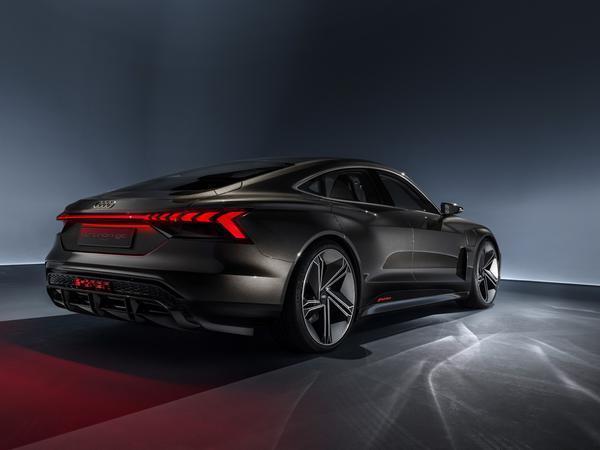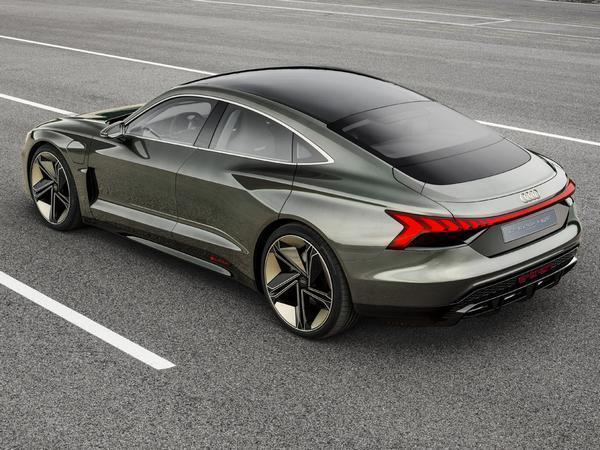Audi to rival Tesla with 590hp e-tron GT
250-mile range concept is already said to be very close to forthcoming production reality

Remember the Audi R8 e-tron from Iron Man 3? Oh, how futuristic that seemed in 2013, with proper sports car performance and design, previewing an electric future with boundless torque and silent speed.
Well, it turns out Audi recalls the film very well, and the future is actually about 18 months away. That's because, not only will this e-tron GT make production in 2020 (and be way faster than that R8), but its maker also saw fit to use Robert Downey Jr to reveal the car in Downtown LA, a handful of miles from Hollywood. Make no mistake: the e-tron GT, indeed the whole e-tron programme, is a very, very big deal for Audi.
So what is it? Well, officially it's a "highly dynamic coupe with a low floor", boasting technology developed with Porsche plus design and character "packed full of unmistakable Audi DNA." It's 4.96m long, 1.96m wide and 1.38m tall, with a 2.9m wheelbase. That makes it a tiny bit shorter, 5cm wider and a little lower than an A7. From what can be surmised, it seems like the Porsche-developed technology will be in the platform and powertrain - both Taycan and e-tron GT are going to use the Premium Platform Electric architecture, with the Audi boasting 590hp from its twin electric motor setup, just 10hp behind the Porsche.

Audi reckons the e-tron GT will be capable of 0-62mph in 3.5 seconds, 0-124 in just over 12 and a limited top speed of 149mph. Iron Man's R8 from just five years ago apparently boasted 4.8 seconds to 62mph and 124mph flat out. Range for this car is over 250 miles by WLTP, and the 90kWh battery can be charged wirelessly or plugged in. Thanks to the car's 800-volt system, the latter can provide 200 miles of range in 20 minutes with the right charging infrastructure.
Range is also boosted (by up to 30 per cent, it's suggested) through recuperation, involving both the two electric motors and the electrohydraulically integrated brake system - meaning there's manual coasting recuperation, automatic coasting recuperation and brake recuperation. Only when a braking force of more than 0.3g is required (apparently only 10 per cent of all decelerations) are the ceramic rotors employed, the rest being taken care of by the electric motors. Interestingly it's claimed the e-tron GT's centre of gravity is lower than that of an R8, thanks to the flat design of the batteries.

With Audi keen at the (nearly) Hollywood reveal to stress how close this car is to production, it's understandable that the e-tron GT is perhaps not as dramatic as recent concepts like the PB18. Audi points to the model's sloping roofline, a cabin that tapers towards the rear and wheel arches that are "sculpted emphatically" around 22-inch wheels. The colour, in case you were wondering, is 'kinetic dust' - no joke. It's designed to be "practical without being 'technoid' standoffish" - whatever that mean. Anyway, it's a handsome show car in the flesh, albeit one that could probably be in production already - whether that says more about Audi's current design language or the slightly conservative styling of this concept, we wouldn't like to say.
Inside, the e-tron GT boasts a vegan interior, with synthetic leathers and materials used throughout. As you'd expect it's a lavish cabin, both in the pics and real life, minimalist yet luxurious as well. Furthermore, while it can't be seen here, there's 550 litres of carrying capacity - 100 litres at the front, 450 in the rear.
So there it is, your kinetic dust look at the future. Best get used to it, too: in addition to the e-tron SUV shown in September, the e-tron GT will eventually be joined by an e-tron Sportback as well - indeed Audi says there will be 12 all electric models by 2025, covering "every relevant market segment". This e-tron GT will reach volume production in 2020 - developed by Audi Sport, no less - and first deliveries are expected early in 2021. Wonder what Iron Man will be driving by then.









Porsche plan 20,000 of these cars a year (no idea if that includes the Audi version. I bet tesla are scared of that.
VAG? well they might have production of 200,000 EVs by 2020.
If anyone challenges Teslas volumes within the next 2-4 years it will be Koreans and Chinese.
Germany will catch up but not until mid next decade.
Tesla in 20 years? Who knows, I would put my money there rather than GM or Ford though.
Whilst I genuinely hope that Tesla do survive, I fear that they don't have the staying power (or cash reserves) to make it through. Elon is a very, very interesting guy with a lot of good ideas, but he's unfortunately made the same mistake as many others by assuming that the car industry is old and inefficient and entered it with an attitude of 'I can do it better'.
Unlike the tech business, the automotive industry is incredibly hard to revolutionise due in part to the massive raft of legal and safety requirements that one must abide by. Being vertically integrated is a great idea, but the reality is it's very money inefficient. It's actually far better to let your suppliers take the legal and financial risk of developing stuff than it is yourself. Even just assembling cars is risky enough (as outlined by Numeric), so once you start adding sub component design, approval and manufacture to that, you're opening yourself up to a lot of risk.
So you clearly don't 400 mile range then? Either that or you're going to be sending the XC90 back. You'll actually have to stop on the way down! My God!
In all honesty, if you really wanted to, you could make this Audi or a Porsche Taycan work. I'm assuming you already have a 7kW charge point at home now as you have a PHEV which realistically needs charging to achieve that real world 346 mile range (if not it will be around 300 miles I guess). With Ionity expanding over Europe already you'd be able to charge the Audi probably quicker than you can fuel 70L, go in, pay, use the toilet, buy a croissant and wait for your missus to powder her nose, and I suspect the Audi would actually be a lovely car to own....and a lot more dynamic than the XC90 (which is a lovely car, but it's very much an SUV in the way it drives).
But then....having an EV probably wouldn't suit the 'I don't care' image you like to project. Wouldn't want anyone thinking you were brash enough to be showing off....
I do appreciate the instant acceleration but that’s about it.
I might re-appraise EV's in 10 years or so, but at the moment, for me, with recharge times and inability to use the performance without compromising the range, they are as much use as a chocolate fireguard. Translate this Audi's name into French and you'll pretty much sum up my view on them.
Even in the 5 min example, a 350kWh Ionity charger would add 30kWh to this Audi (or the Porsche). If we assume absolutely terrible efficiency (which would be 30kWh/100km) that's still 60 miles on top of the maybe real world 220 miles.
If you go for a wee and coffee, it's 90kWh which is another 300km or 180 miles or range.
The Ionity chargers aren't everywhere at the moment, but they will be in the next year (when the e-Tron comes out). As many have said, EVs still aren't appropriate for absolutely everyone, but it is perfectly possible to do long journeys. Even using 50kWh chargers, it's really not much of an inconvenience, and the 350kWh ones the Taycan and e-Tron will charge from will basically match the convenience of Petrol/Diesel.
Your non brand specific smart phone has a peak load capability which isn’t a great deal higher than the constant power draw. So the EV pack may only run routinely at 5-10% of its peak load capability, vs 50% or more for your phone. Since it’s the discharge and recharge rate that effects life so much, you actually find that degradation on the EV battery is tiny due to the low stress during 99% of its life. If you constantly used the car for circuit racing though, that’s a different story...
Gassing Station | General Gassing | Top of Page | What's New | My Stuff



